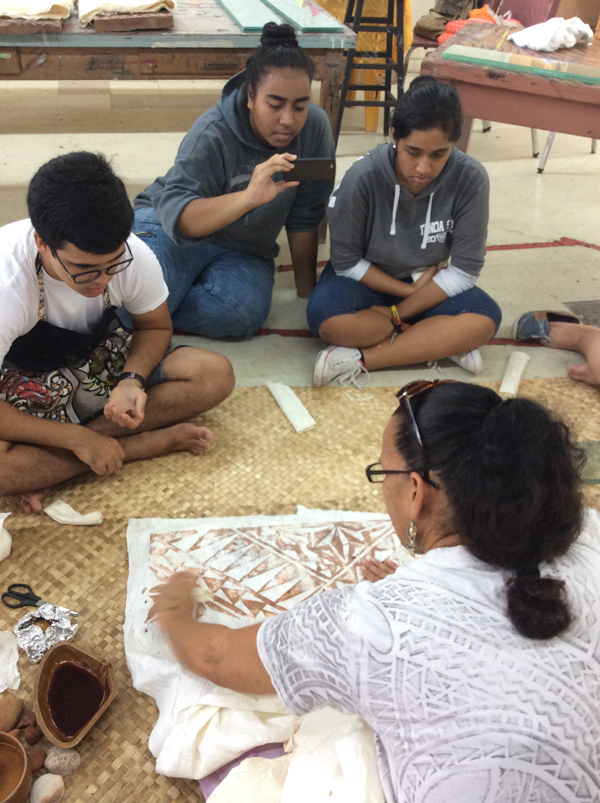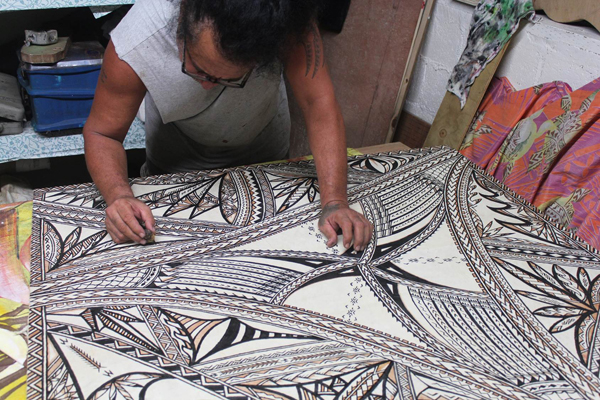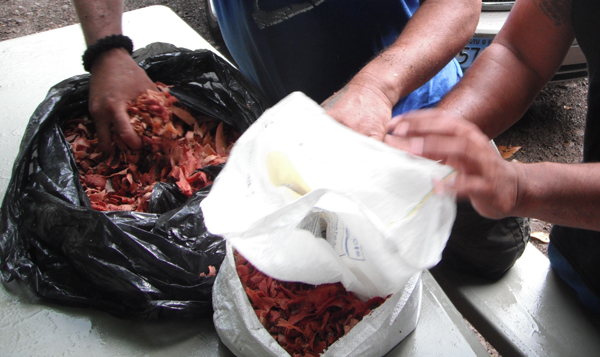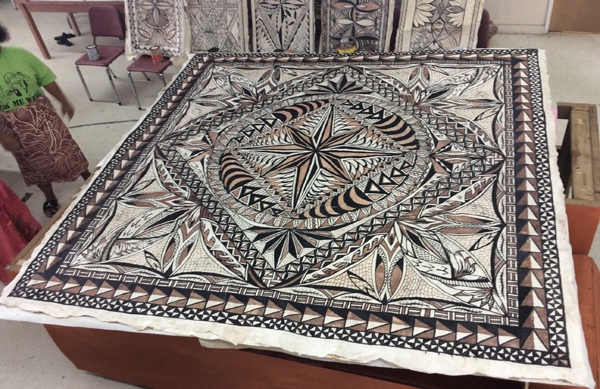Dyes for Samoan Siapo with a focus on ʻOʻa
By Regina A. Meredith Fitiao, MFA
Siapo maker, Leone, American Samoa
Note: Much of the information shared in this article was passed on to me while working alongside my Aunties Mary J. Pritchard, and her daughters Marylyn Pritchard Walker and Adeline Pritchard Jones, who were master siapo makers in American Samoa.
Siapo is the Samoan word for painted bark cloth, which many refer to as tapa. Making a siapo from start to finish requires many steps which includes making the uʻa1 cloth from paper mulberry (Broussonetia papyrifera) and preparing it for either Siapo elei2 (rubbing method on a carved designed board, Figure 1) or Siapo mamanu (freehand method where the siapo maker paints motifs directly onto the uʻa, Figure 2). No matter which of the art styles created, both involve the gathering of natural dyes for painting Samoan motifs onto bark cloth, which is one of our cultural art forms used in many ceremonial events3.


There are four basic dyes used for siapo: oʻa4 (brown, Bishofia javanica), lama5 (black, Aleurites moluccana), ago6 (yellow, Curcuma longa or turmeric root) and loa7 (red, Bixa orellana). All of the dyes come from roots of plants, berries, seeds or inner bark of trees. Each dye is made and used in their pure natural state and contain no additives. Usually the ʻoʻa, lama, and loa will now be stored in glass containers once they are made and kept in a cool place, but the ago is made fresh unless it is mixed with some oʻa to make a golden yellow. While each of the Samoan dyes have been mentioned here, it is the oʻa dye that will be the focus of this article because it is considered the main dye in siapo making.
Although there are different plants that can provide a brown color, such as togo8 (Rhizophora mucronate), siapo makers prefer to use the brown from the oʻa tree found in the bush. Selecting a large oʻa tree is best, which is usually decided upon by sight. The best time for scraping the bark of the tree is in the morning when the dew is still on the leaves. Certain things are taken to the site which include a pelu (machete), ʻasi (a semi-sharp edged pipi shell or tin can lid), a palm frond woven basket or a large plastic bag for collecting the shavings, and once at the site, lau faʻi (banana leaves) or lau taamu (elephant ear leaves) will be gathered as needed. It is also a good idea to wear clothing that is ok to get stained or soiled because if the dye gets onto your clothes it will be permanent.
To begin the process, it is wise to clean the outer debris on the tree and its surroundings so that when the scraping begins, the inner bark will be relatively clean. Scraping the outer layer of bark to reveal the inner bark is also done. This will indicate how moist and juicy the inner bark is. Sometimes the tree will begin to drip and it looks red while the skin of the tree looks pink. Some call it the blood tree because it looks like its bleeding once we begin scraping. When the outer layer is gently scraped off, lau faʻi or lau taamu leaves are laid around the trunk of the tree. These leaves are used to catch the shavings. In the old days a shell would be used for scraping, but nowadays we prefer to use the end of a tin can. When scraping, it is vitally important not to go too deep, otherwise the scraping can hurt or even kill the tree. Therefore, only the pink skin of the bark is scraped and collected (Figure 3). Once it gets to the inner whiter part, we leave it be. When the oʻa shavings begin to fall onto the leaves, they are gathered up and placed in the basket and covered to keep the moisture in the bark. Scraping will continue until there appears to be enough for whoever needs brown dye, and usually there can be anywhere from half gallon to a gallon's worth of shavings in the basket.
As a gesture of respect for the oʻa tree and its ability to provide this beautiful rich dye, we extend our gratitude by rubbing onto the scraped skin some of the rich soil that surrounds the tree. This covering acts as protective measure and allows the tree to begin its recovery. It will usually take the tree about three years to rejuvenate before it is scraped again in the same section.
Once we have enough shavings, we next squeeze the bark shavings to get the dye. There are a few ways we can extract the oʻa dye from the shavings. In the old days, a woven unu or to made of fau fiber (Hibiscus sp.) was used to squeeze large amounts of oʻa. Today's preferred way is to either use a coconut fiber strainer and squeeze by hand (for smaller amounts), or grab an empty rice bag and wring out the juice with the twist of the bag using a stick made of hardwood. If we have a good amount of shavings, the latter method is usually the standard practice. The empty rice bag is opened at both ends and filled with the oʻa shavings and then rolled up like a donut (Figure 4).

When the bag is formed, the roll is placed on a protruding stick about 2-3 inches in diameter that can be made from any hardwood. It is important to make certain this stick is secure and strong as it will need to withstand a relatively heavy amount of pressure from the person twisting the roll using a smaller stick. Placing downward pressure on the rice bag roll while twisting extracts the dye from the shavings. A clean bowl held under the bag catches the beautiful rich brown oʻa dye (Figure 5). The twisting of the rice bag roll in one direction and then reversing the motion will get the most out of the shavings. When it appears that the twisting has extracted the liquid, the rice bag is emptied out and refilled with more shavings until finished. The liquid will then be transferred into a glass jar and left with the lid slightly open for at least 3 days to allow the dye's natural gases to escape. It is important to keep the dye in a cool shady place so that it can maintain its liquid form. Sometimes if left unattended or unused for a time, the oʻa dye will thicken and coagulate. It is always good practice to make just enough to use without counting on storing the dye for long periods of time.
Finally, when all the steps are completed, the brown dye is ready to use. The oʻa dye is considered the main dye in siapo making because it is used for mixing the other three colors. In addition, the oʻa dye has a natural sheen when it dries which almost acts as a sealant when applied to the uʻa, even if it is applied over the black lama dye. Siapo makers will apply one to three coats of oʻa to their siapo work. While at first the dye might appear somewhat light, it will continue to darken as the dye ages (Figure 6). The most appropriate way to apply the oʻa dye is to use a paogo9 or pandanus (Pandanus samoensis) fruit key (or carpel, which is a section of the fruit) that when dried can be trimmed and used as a brush. The paogo is compatible with the natural dyes as it has the ability to hold the dyes while applying them to siapo. Overall, the making of our dyes to sustain one of our ancient art forms continues to be an integral part of our cultural identity. It is our profound hope that meaningful hands-on activities such as the making of siapo and the gathering of the dyes such as the oʻa will continue to be a part of our living heritage.

End Notes:
1 Broussonetia papyrifera or paper mulberry requires peeling, soaking, conditioning and pounding the inner bast to make soft semi-white sheets of beaten bark.
2 Siapo elei, the rubbing method, will also use ʻele, a reddish-brown rock, that when used with our brown dye enhances the rubbed designs.
3 Siapo is used for an array of events such as the bestowal of a chiefly title, ava ceremony, weddings, funerals, gift giving, or traditional wear for a chief or taupou (chief's daughter), just to name a few.
4 Bishofia javanica also has medicinal properties.
5 Aleurites moluccana at one time was also used for the traditional Samoan tattooing.
6 Curcuma longa or the turmeric root which also has medicinal properties can also be used for cooking.
7 Bixa orellana is seasonal and is also referred to as the "Lipstick tree". The red berries are also used for cooking.
8 Rhizophora mucronate is a brown dye source that grows in mangroves.
9 The scientific name for the paogo brush is Pandanus samoensis which is also used as a source of fiber for weaving.
References:
Pritchard, Mary J. Siapo Bark Cloth Art of Samoa, American Samoa on Culture, Arts and Humanities, American Samoa, 1984.
Regina A. Meredith Fitiao has a Master of Fine Arts in Painting and Drawing from San Diego State University, San Diego, CA. Since 1989, she has been a Professor of Art at the American Samoa Community College, Pago Pago, American Samoa. She has received numerous grants and awards and has exhibited her work in museums and galleries world-wide.
 Turkey Red Journal
Turkey Red Journal